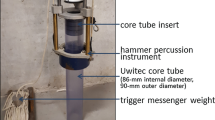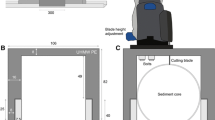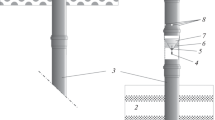Abstract
Shallow water environments are often difficult ones from which to recover undisturbed sediment cores, lending themselves to neither deep water sampling, nor techniques employed for wetland areas. The most simple and obvious way to obtain a core in water depths of less than 2 m is to drive a core tube directly into the sediments using some form of push rod or a percussion (hammer) device. A core driven by percussive methods, however, may be difficult to recover and sealing the tube may be problematic for retention of the sample. Here we describe a simple coring device designed for shallow water operation. The design contains elements of both deeper water gravity and directly driven push rod coring equipment. The device can recover cores up to about 1 m in length in water depths up to about 3–4 m deep. The sampling device has been tested over a number of years from diverse limnological settings (high and mid-Arctic lakes, temperate lakes) with consistently satisfactory results.




Similar content being viewed by others
References
Bennion H, Sayer C, Tibby J, Carrick H (2010) Diatoms as indicators of environmental change in shallow lakes. In: Smol JP, Stoermer EF (eds) The diatoms: applications for the environmental and earth sciences, 2nd edn. Cambridge University Press, Cambridge, pp 152–173
Fisher MM, Brenner M, Reddy KR (1992) A simple, inexpensive piston corer for collecting undisturbed sediment/water interface profiles. J Paleolimnol 7:157–161
Glew JR (1989) A new trigger mechanism for sediment samplers. J Paleolimnol 2:241–243
Glew JR, Smol JP, Last WM (2001) Sediment core collection and extrusion. In: Last WM, Smol JP (eds) Tracking environmental change using lake sediments. volume 1: basin analysis, coring, and chronological techniques, vol 1. Kluwer, Dordrecht, pp 73–105
Smol JP, Douglas MSV (2007) From controversy to consensus: making the case for recent climatic change in the Arctic using lake sediments. Front Ecol Environ 5:466–474
Acknowledgments
The design and development of this corer was facilitated by funding from the Natural Sciences and Engineering Research Council of Canada. We thank Brian Ginn for the photographs, as well as J. Curtis and an anonymous reviewer for helpful comments on the manuscript.
Author information
Authors and Affiliations
Corresponding author
Rights and permissions
About this article
Cite this article
Glew, J.R., Smol, J.P. A push corer developed for retrieving high-resolution sediment cores from shallow waters. J Paleolimnol 56, 67–71 (2016). https://doi.org/10.1007/s10933-015-9873-z
Received:
Accepted:
Published:
Issue Date:
DOI: https://doi.org/10.1007/s10933-015-9873-z




